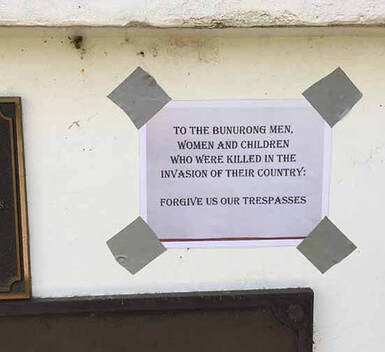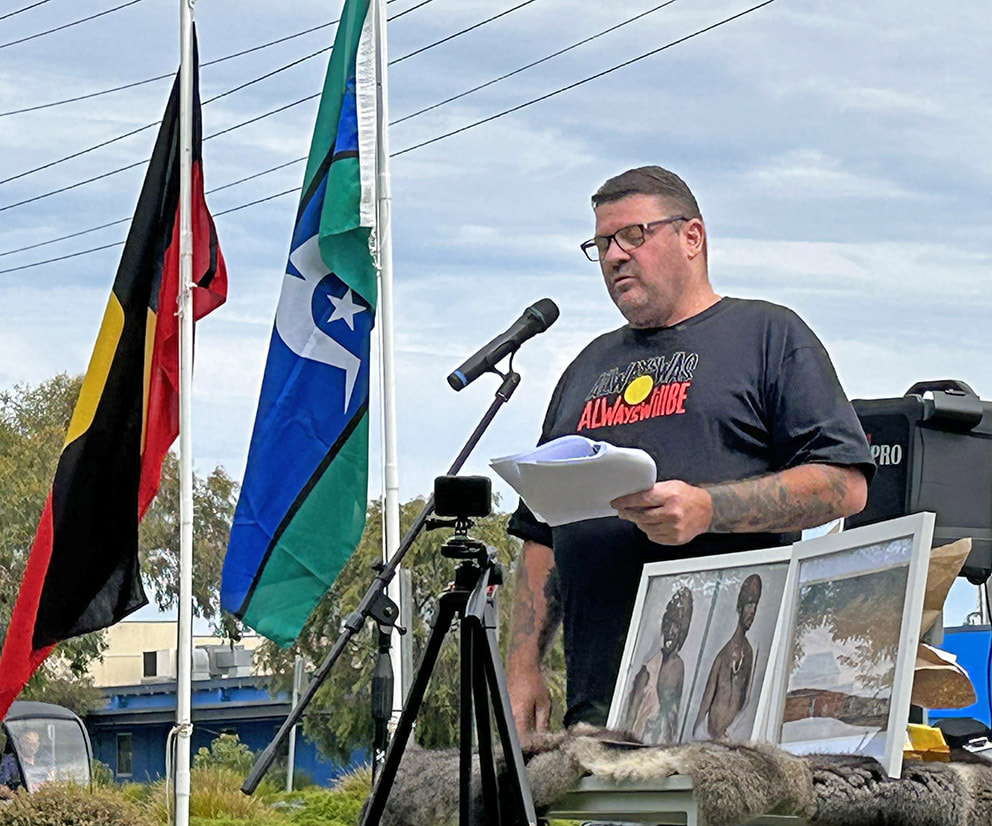 A DIY plaque on the Wonthaggi War Memorial.
A DIY plaque on the Wonthaggi War Memorial. Last week the annual truth telling commemoration for Tunnerminnerwait and Maulboyheenner was held at Wishart Reserve in Wonthaggi. The two Aboriginal men were publicly hanged in Melbourne in 1841 after being convicted of murdering a sealer at what we now know as Harmers Haven. In 2014 Melbourne City councillors voted to fund a memorial to the men, recognising them as freedom fighters.
More than 100,000 Australians have died in overseas wars. We don’t know the number who died during the war in Australia because it was a one-sided campaign and the winners got to tell the story. But facts that are left out of the official history distort our past and mislead us today.
My primary school reader in the 1960s had a story called An Adventure with Blacks, about a narrow escape by white people from blacks with “savage faces”, “wild glaring eyes” and “fiendish expressions”. It terrified some kids.
“Never trust a blackfeller behind your back,” my grade 5 teacher, Sister Benitsi, warned my class.
If you love living here, imagine how much First Nations people must have loved it before the British invasion. An Aboriginal person living near a beach or river in Australia had a better diet and quality of life than the poor in Britain where children aged four swept chimneys and seven-year-olds worked in coal mines. Aboriginal people must have viewed the treatment of convicts, some as young as 10, with disgust and terror.
Explorer Thomas Mitchell thought that Aboriginal people experienced a level of health and an intensity of existence far beyond the enjoyments of civilised men: “They hold that the bush and all it contains are general property. This general claim to Nature’s bounty extends even to the successes of the day, hence at the close, those who had been successful divide with those who had not been so. I have been with them for months without a single altercation.”
| The 1800s was a time when the weak and timid were lawful prey for the resolute and strong. It didn’t matter if you were Scottish, Irish, Chinese, Russian, Indian, Hawaiian, Maori, African or even English. You could be shot, hanged or transported for as little as petty theft or campaigning for the right to vote. According to the New Scientist of 28 November 2015, “documents from 1763 show that during the North American Indian wars in 1763 Lord Jeffrey Amherst, British commander, ordered that blankets and a handkerchief infected with smallpox be distributed among the Delaware Indian tribes. It had the desired effect.” A year after the arrival of the first fleet in 1788, an outbreak of smallpox killed half the Aboriginal population around Sydney. The privatisation and destruction of traditional food areas by the invaders soon led to open warfare between the original inhabitants and the settlers. According to the Powlett Express of 4 October 1940: “A hundred years ago the blacks overran the district”. The reference was to the first British settlement at Corinella, which was abandoned in 1826, leaving behind not just valuable cattle but abundant fish, ducks, kangaroos and nearby muttonbirds. In 1820 Governor Lachlan Macquarie proclaimed that any unarmed group of Aborigines of more than six in number, including women and children, could be legally shot if found within a mile of white habitation. There are many accounts of tribes being slaughtered to the last man, woman, child and infant. The Myall Creek massacre of 1838 is famous not because around 30 women, children and elderly people were murdered but because seven white men were hanged for their murder, sparking general outrage in the settler community. | Whose story is it? “We need to unpack the tale and delve into the lives of Tunnerminnerwait and Maulboyheenner and broaden the narrative. These stories we know today have come from a very small amount of people, and not from Aboriginal people. “These young men were the first people to be hanged by the Government in Melbourne in 1842. The injustice and wrongful treatment toward Aboriginal people during this time ultimately leading to their deaths was abhorrent. “They were only doing what we all would to protect our families. The treatment of our Country men and women during colonisation had a huge impact. That’s why we come together to honour and pay respect to them each January to acknowledge all who suffered. “This was the beginning of the injustices for Aboriginal people and 180 years later we are still asking if anything has really changed. It’s a critical chapter in our shared history. If we are truly going to move forward in reconciliation we all need to understand that Aboriginal people want to have a voice – let’s give them a voice and justice.” Robert Ogden, Bunurong Traditional Owner, speaking at the annual truth telling commemoration day in Wonthaggi, organised by the Bass Coast Reconciliation Network. |
The convictions and punishment after Myall Creek were intended by Governor Gipps to stop the massacre of Aboriginal people. As Gil Jones notes in Bulga Bala Boree, the killing didn’t stop; it merely went underground. “The perpetrators no longer openly bragged about their deeds and worked harder to conceal any evidence.”
As in most wars it was the desperately poor dispensable workers at Myall Creek who were hung, not the wealthy landholders who had implicitly or covertly given the orders.
In July 1843 Angus McMillan and the Highland Brigade murdered between 60 and 150 Gunaikurnai people at Warrigal Creek in retribution for the murder of a local white man.
Three years after the massacre, travelling through Gippsland, Henry Howard Meyrick wrote to his mother in England: “The blacks are very quiet here now, poor wretches. No wild beast of the forest was ever hunted down with such unsparing perseverance as they are. Men, women and children are shot whenever they can be met with … I have protested against it at every station I have been in Gippsland, in the strongest language, but these things are kept very secret as the penalty would certainly be hanging … It is impossible to say how many have been shot, but I am convinced that not less than 450 have been murdered altogether.”
In 1926 the self-appointed Victorian Historical Memorials Committee decided to glorify McMillan and the Polish explorer Paul de Strzelecki with a chain of historical cairns across Gippsland, from Heyfield to Corinella.
Strzelecki was a man of science without a god or commercial interests. Having witnessed the avarice and barbarity of European settlement, he put his faith in social reform. He believed there were as many roads to contentment as races of mankind, that life’s fundamental relationship was between man and nature.
In 1840, he led a small exploration party from the Murrumbidgee River in New South Wales through Gippsland to Melbourne. The forest was so dense in parts that they could only do two to three kilometres a day. Their stores ran out and they survived only with the knowledge and hunting skills of their Aboriginal guide, Charlie Tarra, whom Strzelecki described as “a clever and good fellow … who deserves the most credit”. They arrived at Settlement Point (now Corinella) in May, 1840.
The original plaque on the Corinella cairn had the names only of Strzelecki and James Riley. It was later revised to include Charlie Tarra and the other members of the party.
After their journey Strzelecki wrote this on behalf of Aboriginal people: “Leave us our habits and our customs. Do not embitter the days that are in store for us by constraining us to obey yours nor reproach us with apathy to that civilisation which is not destined for us and if you can still be generous to the conquered, relieve the hunger which drives us in despair to kill your flocks. Our fields and forests which once provided us with abundance of vegetable and animal food now yield us no more. They and their produce are yours. You prosper on our native soil and we are starved.”
Aboriginal soldiers who fought in WWI came back to find themselves still treated as objects of derision and scorn. According to the Department of Veterans Affairs, only one Aboriginal soldier is known to have received land under the post-war Soldier Settlement Scheme.
A month after the landing at Gallipoli, a rumor went around Wonthaggi that it was a disaster. When recruitment fell off, the local Federal MP, Mr. Watt, tried to shame reluctant local youths into fighting for the British Empire. He is quoted in the Wonthaggi Sentinel of 9 July 1915: “We should be a race like the Aboriginals of this country. Even those benighted heathens put up some sort of fight with the primitive weapons they possessed.”
The recent decision by the Australian war memorial council to recognize the 100-year-long Australian war shows us that slow accumulative campaigning works. I hope one day we see a tomb of an unknown local warrior next to the grave of the Unknown Soldier.
References:
- Victorian Readers Fifth Book, Education Department of Victoria, 2nd Edition, 1940.
- Caledonia Australis by Don Watson
- Life in the Bush by F.J Meyrick
- Bulga Bala Boree. Country and culture. Pastoral invasion and Dakinyung dispossession Hawkesbury to Hunter, by Gil Jones, St Albans, self-published, 2017.
- Waterloo Creek. The Australia Day massacre of 1838, George Gipps, and the British conquest of New South Wales, by R Milliss, McPhee Gribble, Ringwood, Vic, 1992.
